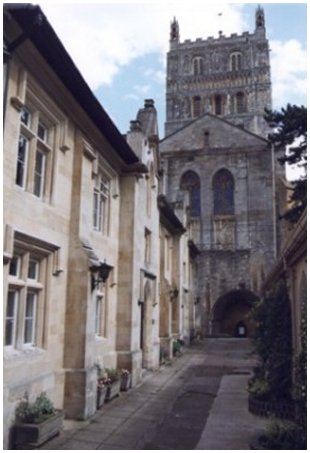 I am enough of a news junkie that I really enjoy popping open a dead-tree-pulp newspaper and bumping into a story that is totally off my radar.
Take, for example, the news feature by Mary Jordan of the Washington Post Foreign Service that ran with this double-decker headline: "British Thieves Ripping Off the Roofs – Historic Churches Suffering as Value Of Lead Skyrockets."
I am enough of a news junkie that I really enjoy popping open a dead-tree-pulp newspaper and bumping into a story that is totally off my radar.
Take, for example, the news feature by Mary Jordan of the Washington Post Foreign Service that ran with this double-decker headline: "British Thieves Ripping Off the Roofs – Historic Churches Suffering as Value Of Lead Skyrockets."
Say what? Here's the opening of this story, which begins at the 12th-century Tewkesbury Abbey (photo):
"It's awful. It's disastrous. It's incredibly sad," said Antonia Black, a local artist sitting in a cozy delicatessen on the town's quiet main street.
In addition to the abbey, she said, two other local churches have experienced their roofs being stripped, including one she had just visited: "On Sunday, we were sitting in service and the vicar said, 'Look up,' and we could see the sky."
The rooftop thefts, which have reached epidemic proportions, with more than 1,000 churches hit this year, are a function of the cost of lead. It has jumped from $450 a ton five years ago to $3,200 this year, according to police and insurance industry officials.
Can you imagine this scene? Some of the roof robbers are working in broad daylight, ripping off tons of lead while onlookers assume that they are doing repairs. Then, after the roofs are repaired with materials that meet historic guidelines, they come back and do it again.
The statistics are amazing:
"Churches have always been a target for thieves, but this is particularly shocking because they are ripping the very fabric off the building," said Chris Pitt, spokesman for Ecclesiastic Insurance Group, a company that insures 16,500 Anglican churches in the United Kingdom.
More than 2,000 claims have been filed for metal thefts at churches in 2007, compared with 80 claims just two years ago, Pitt said. He said record multimillion-dollar losses are piling up, with the scope of the damage often far exceeding the roofing.
Stone spires have been yanked away to get at the stuff. Holes in roofs have gone unnoticed until downpours inflict further damage, including the destruction of a $40,000 organ in one church.
I really only have one complaint about this tragic yet entertaining story.
When I think about numbers in the Church of England, I think of the membership statistics and the declining number of people in the pews. This is, of course, affecting economics. There are about 21 million people who are supposed to be members in Church of England parishes, yet there are about 1.2 million or fewer in the pews on a typical Sunday.
How are these churches affording all of this repair work? Are these thefts causing any churches to close? Is this tearing at the fabric of all C of E churches, or primarily those in the Anglo-Catholic tradition?
I guess I wanted one or two more paragraphs to complete this stunning picture.
